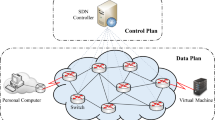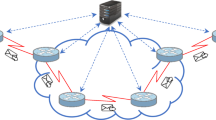Abstract
Software Defined Network (SDN) is a new network technology which allows network providers to afford predefined Quality of Service (QoS) for video streaming applications. Network administrators can develop desired traffic engineering techniques over SDN and support Quality of Experience (QoE) and QoS for their customers. One of the most important issues in traffic engineering is to find favorable links for routing between source and destination. The fitness of each link in the network depends on the end users QoE and the applications they are used. In this paper to achieve optimal routes, the fitness of each link is determined by type-2 fuzzy sets. Then, an adaptive traffic engineering method is proposed to find the best routes between source cameras and monitoring center in a video surveillance system. The proposed method is based on Constraint Shortest Path (CSP) problem and calculates minimum cost path which satisfies delay constraint. Due to NP-completeness of the CSP problems, LARAC algorithm is used to solve it. To the best of our knowledge, this is the first proposed traffic engineering technique which is based on type-2 fuzzy set for video streaming applications over SDN. The contribution of the proposed method regarding to the related works, is to apply type-2 and type-1 fuzzy logic for calculating the costs of network links based on QoE for providing QoS in a video surveillance system. In addition, this paper models the provisioning of QoS in a real scenario and emulates them in a network emulator. Many comparisons carried out between the proposed method and other well-known methods to show the effectiveness of the proposed method in terms of packet loss, delay and PSNR.











Similar content being viewed by others
References
Akyildiz IF, Lee A, Wang P, Luo M, Wu C (2014) A roadmap for traffic engineering in SDN-OpenFlow networks. Comput Netw 71:1–30
Aladi JH, Wagner C, Garibaldi JM (2014) Type-1 or interval type-2 fuzzy logic systems—on the relationship of the amount of uncertainty and FOU size. 2014 I.E. International Conference on Fuzzy Systems (FUZZ-IEEE). IEEE
Baklouti N, John R, Alimi AM (2012) Interval type-2 fuzzy logic control of mobile robots. J Intell Learn Syst Appl 4(04):291
Castillo O, Melin P, Kacprzyk J, Pedrycz W (2007) Type-2 fuzzy logic: theory and applications. In Granular Computing, 2007. GRC 2007. IEEE international conference on, pp. 145–145. IEEE
Dijkstra E W (1959) A note on two problems in connexion with graphs. Numerischemathematik 1, no. 1: 269–271
Dusi M, Bifulco R, Gringoli F, Schneider F (2014) Reactive logic in software-defined networking: Measuring flow-table requirements. In Wireless Communications and Mobile Computing Conference (IWCMC), 2014 International, pp. 340–345. IEEE
Egilmez H, Tekalp M (2014) Distributed QoS architectures for multimedia streaming over software defined networks. Multimedia, IEEE Transactions on 16(6):1597–1609
Egilmez HE, Dane ST, Bagci KT (2012) OpenQoS: An OpenFlow controller design for multimedia delivery with end-to-end Quality of Service over Software-Defined Networks. In Signal & Information Processing Association Annual Summit and Conference (APSIPA ASC), 2012 Asia-Pacific, pp. 1–8. IEEE
Egilmez HE, Civanlar S, Tekalp AM (2013) An optimization framework for QoS-enabled adaptive video streaming over OpenFlow networks. Multimedia, IEEE Transactions on 15, no. 3: 710–715
Hagras H, Wagner C (2012) Towards the wide spread use of type-2 fuzzy logic systems in real world applications. IEEE Comput Intell Mag 7(3):14–24
http://mininet.org/ [Accessed 06 February 16]
http://www.bigbuckbunny.org/ [Accessed 17 March 16]
http://www.cisco.com/c/en/us/products/collateral/physical-security/video-surveillance-6000-series-ip-cameras/data_sheet_c78-714746.html [Accessed 06 February 16]
http://www.videolan.org/vlc/index.html [Accessed 06 February 16]
Jammal M, Singh T, Shami A, Asal R, Li Y (2014) Software defined networking: state of the art and research challenges. Comput Netw 72:74–98
Juttner A, BalazsSzviatovski, IldikóMécs, ZsoltRajkó (2001) Lagrange relaxation based method for the QoS routing problem. In INFOCOM 2001. Twentieth Annual Joint Conference of the IEEE Computer and Communications Societies. Proceedings. IEEE, vol. 2, pp. 859–868. IEEE
Karl M, Gruen J, Herfet T (2013) Multimedia optimized routing in OpenFlow networks. In Networks (ICON), 2013 19th IEEE International Conference on, pp. 1–6. IEEE
Karl M, Gruen J, Herfet T (2013) Multimedia optimized routing in OpenFlow networks. In Networks (ICON), 2013 19th IEEE International Conference on, pp. 1–6. IEEE, 2013.
Karnik NN, Mendel JM, Liang Q (1999) Type-2 fuzzy logic systems. Fuzzy Systems, IEEE Transactions on 7(6):643–658
Kassler A, et al. (2012) Towards QoE-driven multimedia service negotiation and path optimization with software defined networking. Software, Telecommunications and Computer Networks (SoftCOM), 2012 20th International Conference on. IEEE
Kreutz D, Ramos FMV, Verissimo PE, Rothenberg CE, Azodolmolky S, and Uhlig S (2015) Software-defined networking: A comprehensive survey. Proceedings of the IEEE 103, no. 1: 14–76
Liu G, and Ramakrishnan KG (2001) A* Prune: an algorithm for finding K shortest paths subject to multiple constraints. In INFOCOM 2001. Twentieth Annual Joint Conference of the IEEE Computer and Communications Societies. Proceedings. IEEE, vol. 2, pp. 743–749. IEEE
Mendel JM. (2001) Uncertain rule-based fuzzy logic system: introduction and new directions.
Mirzahossein K, Nguyen M, and Elmasry S. (2013) Analysis of RIP, OSPF, and EIGRP Routing Protocols using OPNET. Simon Fraser University, School of Engineering Final Year Project, ENCS 427: Communication Networks
Mohammadi R, Javidan R, Jalili A (2015) Fuzzy Depth Based Routing Protocol for Underwater Acoustic Wireless Sensor Networks. Journal of Telecommunication, Electronic and Computer Engineering (JTEC) 7, no. 1: 81–86
Müller C, Timmerer C (2011) A VLC media player plugin enabling dynamic adaptive streaming over HTTP. In Proceedings of the 19th ACM international conference on Multimedia, pp. 723–726. ACM
Ongaro F, Cerqueira E, Foschini L, Corradi A, Gerla M (2015) Enhancing the quality level support for real-time multimedia applications in software-defined networks. In Computing, Networking and Communications (ICNC), 2015 International Conference on, pp. 505–509. IEEE
Rakheja P et al (2012) Performance analysis of RIP, OSPF, IGRP and EIGRP routing protocols in a network. International Journal of Computer Applications 48(18):6–11
Rec I. (1996) T. U. T. P. 800: methods for subjective determination of transmission quality. international telecommunication union, Geneva
Schulzrinne H. (1998) Real time streaming protocol (RTSP)
Sezer S, Scott-Hayward S, Pushpinder-KaurChouhan, Fraser B, Lake D, Finnegan J, NielViljoen, Miller M, and NavneetRao. (2013) Are we ready for SDN? Implementation challenges for software-defined networks. Communications Magazine, IEEE 51, no. 7: 36–43
Tomovic S, Prasad N, Radusinovic I. (2014) SDN control framework for QoS provisioning. In Telecommunications Forum Telfor (TELFOR), 2014 22nd, pp. 111–114. IEEE
Wang Z, and Crowcroft J (1996) Quality-of-service routing for supporting multimedia applications. Selected Areas in Communications, IEEE Journal on14, no. 7: 1228–1234
www.opendaylight.org [Accessed 06 February 16]
Xiao Y, KrishnaiyanThulasiraman, GuoliangXue, AlpárJüttner (2005) The constrained shortest path problem: algorithmic approaches and an algebraic study with generalization. AKCE International Journal of Graphs and Combinatorics 2, no. 2: 63–86
Yu T-F, Wang K, Hsu Y-H (2015) Adaptive routing for video streaming with QoS support over SDN networks. In Information Networking (ICOIN), 2015 International Conference on, pp. 318–323. IEEE
Zadeh LA (1975) The concept of a linguistic variable and its application to approximate reasoning—I. Information sciences 8, no. 3: 199–249
Author information
Authors and Affiliations
Corresponding author
Rights and permissions
About this article
Cite this article
Mohammadi, R., Javidan, R. An adaptive type-2 fuzzy traffic engineering method for video surveillance systems over software defined networks. Multimed Tools Appl 76, 23627–23642 (2017). https://doi.org/10.1007/s11042-016-4137-0
Received:
Revised:
Accepted:
Published:
Issue Date:
DOI: https://doi.org/10.1007/s11042-016-4137-0




